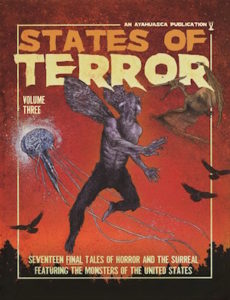 States of Terror, Vol. 3
States of Terror, Vol. 3
edited by Matt E. Lewis and Keith McCleary
It is incredibly easy to become desensitized to the “horrifying”. Mainstream horror, regardless of the medium, all too often mistakes disgust for fear and utilize the grotesque and the visceral without understanding the difference between discomfort and dread. True fear is a thing intimately familiar and yet fundamentally alien, a state of mind that taps into the primal need to survive and defy the vastness of an unfathomable cosmos. Whether we run from the psychopath with a meat cleaver or stare into the eye of a Lovecraftian abyssal, we are reacting to the same drives, the same existential nightmares, and the same fear of oblivion. But when we are exposed to gore or brutality or monstrosity that exists for its own sake, we are subconsciously and unintentionally encouraged that fear is merely a fantasy, a high to be tasted rather than a vehicle to explore what it is to be mortal and of dubious significance.
I believe this perspective is why I enjoyed States of Terror Vol. 3 so much. The book is an anthology of independent short stories that plays out like a menagerie of forgotten dreams. Each story takes up its own “monster”, its own fear-inducing subject, and brings it to life like a scientist too wrapped up in the means to comprehend the ends. But the goal is not to cause fear. This anthology is much smarter than that. It generates real fear through its storytelling, as a byproduct of the tales being told. It does not tell you that you should be afraid. Through consistently quality writing, it describes things that are genuinely terrifying and allows you to confront them yourself.
and forced more and more of my hand inside the widening and convulsing opening I created, working the lower jaw down farther from the upper until at last with a little elbow grease and a heave it gave way with a crack,
– Justin Hudnall, “Hierarchy of Meats”
In order for the fear to not be the ends, the characters must be multi-dimensional. States of Terror takes this idea and fully embraces it, not only giving their characters depth but fleshing out the emotions and psychologies of both predators and prey. There are no damsels in distress, mindless heroes, or inexplicable villains. Moreover, the lines between the supernatural and the psychological are so blurred they might as well be nonexistent. Some stories present very human dangers and distrust. Others present nightmares given form, existing to spite the notion of the impossible. Many stories can be seen as the minds of victims processing trauma. All of the stories make a point to give that which are afraid of a relatable dimension. The things that drive the monsters are the things that drive us, and the reader is left unable to honestly say where one ends and another begins.
Hunger: a stone. Ache in the gut, twist in the spine, red behind the eyes. Sharpness of the teeth hunger. Frog bird frog fish mud hiker stork coon possum frog—sharper sharper sharper every bite. My stomach, not: fullness. An elsewhere hunger in words.
– Gabriella Santiago, “Words and Things”
That ambiguity is the source of the most fundamental dread in States of Terror. Our own minds are often the best tools with which to scare us, allowing our imaginations to conjure the most personal of demons. This anthology understands this and, while it uses ideas and creatures with some notoriety, it draws the reader in and leaves the reader staring at mutated fun-house reflections.
On a more basic level, States of Terror, Vol 3. is just plain well-written. It never really insists upon itself and it uses spine-tingling creepiness to create layer upon layer of atmosphere. Some stories are very traditionally delivered, with concise effectiveness and little to no wasted space. Others play with language as the inconstant medium that it is, denying the reader an easy pace and drawing every word and phrase into focus like the digits and limbs of a corpse that has been bent into a disturbingly creative new shape. The changes in style really help the readability of the whole anthology. None of the stories feel like duplicates. Those that have more familiar elements engender the feeling of exchanging sweat-inducing tales around a campfire. Those that are more experimental are like the instant of waking up in the middle of the night and hoping that reality is as you remember it.
Her that looked like me but was cold and hairless. Felt the growing cold and the swift darkness. Dragged her into the light, the orange beacon where stones were thrown and I tasted salty descending. Slowly. Into the warmth of the ruddy whispers and watched her boil.
– Janice Lee, “Growing Colder”
One thing about this book that cannot be overlooked is that, while it is the last of a three part series, it stands entirely well on its own, not unlike the stories that comprise it. I have not read either Vol. 1 or Vol. 2, and while reading Vol. 3, I never felt like I was missing part of the experience. That said, the quality of Vol. 3 is such that I now fully intend to read both of the first two volumes. States of Terror, Vol. 3 is fun and dread-inducing and it remains quality literature throughout, never forgetting what it set out to do.
States of Terror Vol. 3 is available now through Ayahuasca Publishing

